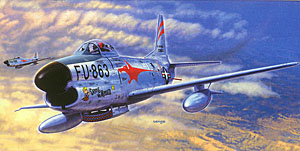Monogram Promodeler 1/ 48 scale F-86D Dog Sabre, Kit 5960
|
|
Overview
When I heard that Promodeler was going to issue the F-86D, I knew that
I would break my self-imposed limitation to WWI kits and snap one up instantly
as soon as it was released. I have always been surprised by the lack of
a modern quality 1/48 F-86D on the market, since the Air Force flew so
many of them; some 2500 airplanes in 20 wings. Until now, modelers could
search for the long extinct Entex kit, and pay collectors prices or buy
the Collect-Air resin kit, which also boasts a hefty price tag. In fact,
I continue to be surprised at the lack of F-86 variants (A’s, E’s &
H’s) save for the F-86F, which has been done very well by Monogram, Minicraft
& Tamiya. Finally the interminable wait was over. I admit that I 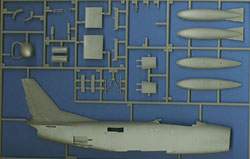 tore
the shrink-wrap open in the car and gave the kit a thorough inspection
before leaving the parking lot. tore
the shrink-wrap open in the car and gave the kit a thorough inspection
before leaving the parking lot.
The Kit
The kit consists of 119 pieces packaged in 3 sturdy poly bags; the fuselage,
the wings & tractor with tow bar (a really nice touch for the diorama
makers).
I was first drawn to the wings, as I wanted to see how the leading edge
slats would be handled - a prominent differentiating feature of all early
Sabres. The leading edge slats were a device to enhance lift at low air
speeds. The Sabre’s slats moved in and out with aerodynamic forces and
were not powered. The slats on this model are well executed. The slat
supports should exit the top and bottom of the leading edge of the 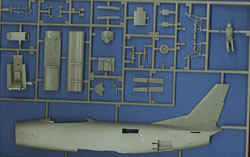 wing
but these supports are molded into the top edge of the wing. This is a
very minor deviation. It appears to have been done this way to facilitate
modelers who would remove the supports and model the aircraft in flight
with the slats in the up position. It saves the modeler from filling the
exit ports on the bottom of the wings. The closed support slots are molded
into the bottom wing. Very well thought out. wing
but these supports are molded into the top edge of the wing. This is a
very minor deviation. It appears to have been done this way to facilitate
modelers who would remove the supports and model the aircraft in flight
with the slats in the up position. It saves the modeler from filling the
exit ports on the bottom of the wings. The closed support slots are molded
into the bottom wing. Very well thought out.
The recessed panel lines on the wings and the tooling are impressive.
Very fine boundary layer fences have been molded on to the horizontal
stabilizers and on parts of the fuselage. This enhances the accuracy of
the model, but may be difficult to cover in foil if that is your preferred
finishing method.
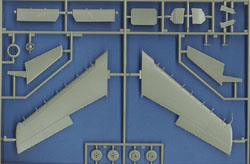 The
wheel hubs are highly detailed. I have never liked the recent trend in
flattened bulging tires. Attempts at molding this have never looked right
to me. Thankfully Promodeler has omitted this feature on this kit. The
wheel hubs are highly detailed. I have never liked the recent trend in
flattened bulging tires. Attempts at molding this have never looked right
to me. Thankfully Promodeler has omitted this feature on this kit.
As I was inspecting the wing sprues, I noticed another really nice touch.
The sprues have pin & sockets molded into them.
This allows the sprues to be stacked so that parts do not rub against
each other in the poly bag, avoiding scratches that would need to be removed
for painting. Somebody in the design department needs a raise!
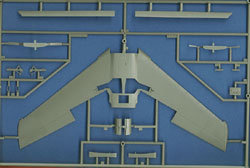 The
fuselage section looks very nice. I am particularly pleased with the
presence of the nose landing light as a socket with a clear lens piece.
The next thing that caught my eye was the very large trim-tab on the rudder.
This did not seem to be standard for F-86Ds. I have since been told that
this model was based on the example in the Air Force museum (markings
for 52-3863 are included in this kit). This particular airplane was used
for aerodynamic studies (originally serialed 50-477) and has an oversized
trim tab that was not present on any other F-86D. It should be a simple
fix, should you decide to model a different D. The modeler should also
be aware that this kit represents Ds of production block 40 or earlier.
Starting at block 45, a drag ‘chute and fairing was installed. Purchase
the Revell-Germany release to model an aircraft from a later production
block. I am told that it is a D-45 with the drag ‘chute housing (see
the review on the Revell-Germany kit here). Alternatively, you could
reshape the area between the vertical stabilizer The
fuselage section looks very nice. I am particularly pleased with the
presence of the nose landing light as a socket with a clear lens piece.
The next thing that caught my eye was the very large trim-tab on the rudder.
This did not seem to be standard for F-86Ds. I have since been told that
this model was based on the example in the Air Force museum (markings
for 52-3863 are included in this kit). This particular airplane was used
for aerodynamic studies (originally serialed 50-477) and has an oversized
trim tab that was not present on any other F-86D. It should be a simple
fix, should you decide to model a different D. The modeler should also
be aware that this kit represents Ds of production block 40 or earlier.
Starting at block 45, a drag ‘chute and fairing was installed. Purchase
the Revell-Germany release to model an aircraft from a later production
block. I am told that it is a D-45 with the drag ‘chute housing (see
the review on the Revell-Germany kit here). Alternatively, you could
reshape the area between the vertical stabilizer 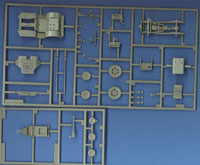 and
the exhaust. References will be helpful. and
the exhaust. References will be helpful.
The cockpit looks like it will be a lot of fun. A nicely detailed tub
has been supplied as well the tubular seat support that should look great.
The radarscope shroud has been supplied as well. The seat appears to be
accurate according to my references, but I would prefer that the seatbelts
not be molded in to the seat cushion. I will remove this detail and add
my own belts and buckles.
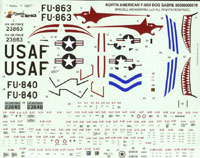 The
F-86D had a lot of stencils and the extensive decal sheet looks like it
has every one of them. The sheet supplies 2 sets of markings one for 52-3863
of the 97th FIS “Dennis the Menace” as mentioned earlier. The
instructions call out the second markings set as being from the 498th
FIS “Gieger’s Tigers”. This is a common error that has propagated through
the years and unfortunately some reference books. The markings actually
belong to an aircraft from the 520th FIS. The 520th
FIS was later redesignated the 498th FIS, but there were some
subtle changes to the markings – notably the number of stars on the canopy
and the addition of a tiger’s head on the tail. I will not use either
of these. My Dad flew the “D” for ~ 6 years with the 4th FIS
out of Misawa AFB in Japan and with the 49th FIS out of Hanscom
Field, in Bedford, MA. I will probably end up modeling both of these. The
F-86D had a lot of stencils and the extensive decal sheet looks like it
has every one of them. The sheet supplies 2 sets of markings one for 52-3863
of the 97th FIS “Dennis the Menace” as mentioned earlier. The
instructions call out the second markings set as being from the 498th
FIS “Gieger’s Tigers”. This is a common error that has propagated through
the years and unfortunately some reference books. The markings actually
belong to an aircraft from the 520th FIS. The 520th
FIS was later redesignated the 498th FIS, but there were some
subtle changes to the markings – notably the number of stars on the canopy
and the addition of a tiger’s head on the tail. I will not use either
of these. My Dad flew the “D” for ~ 6 years with the 4th FIS
out of Misawa AFB in Japan and with the 49th FIS out of Hanscom
Field, in Bedford, MA. I will probably end up modeling both of these.
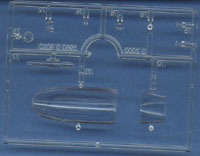 The
instruction booklet is very well done featuring an aircraft history, stencil
placement drawings, and lots of helpful photos from Bert Kinsey of Detail
& Scale. The
instruction booklet is very well done featuring an aircraft history, stencil
placement drawings, and lots of helpful photos from Bert Kinsey of Detail
& Scale.
I have one suggestion for improvement. The kit does not naturally sit
on its gear. It will either require weight in the nose or that the modeler
use the supplied clear plastic support rod to make the model sit correctly.
I would like this fact to be called out more prominently in the instructions
and a weighting recommendation.
Conclusions
This kit is a beauty. The molding techniques and overall quality are
second to none. I paid $22.50 at my local hobby shop for this kit. I
feel I received a good value for my money and that the price is very competitive
when compared to kits of equivalent size and quality from other manufacturers.
I am definitely going to enjoy building this one.
| 


 




|
